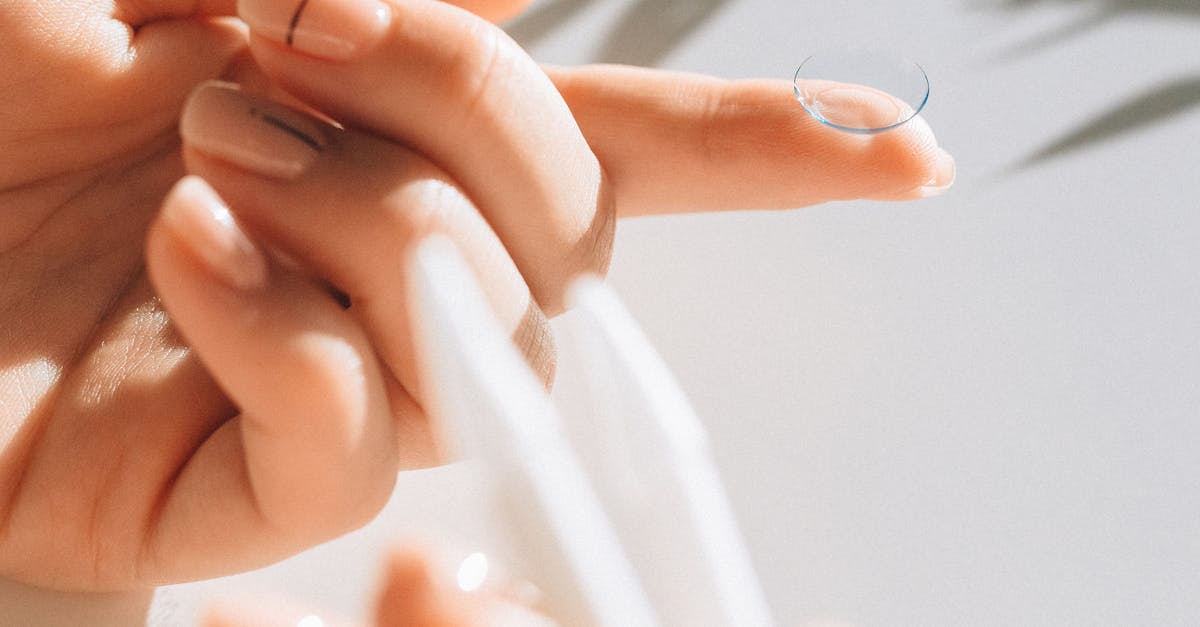If you wear contact lenses, you probably know the feeling. Your vision starts out crystal clear in the morning, but by the end of the day, it’s like looking through a fogged-up window. This frustrating experience is usually caused by contact lens protein deposits—a natural, yet pesky, buildup from your own tears.
For our patients here in Glendale Heights and the surrounding communities like Carol Stream, clear and comfortable vision is non-negotiable. At iDoctor, we believe the best way to tackle this common problem is to first understand what’s happening right on the surface of your eye. This guide breaks it all down, from what causes these deposits to how you can keep them from ruining your day and clouding your view of local landmarks like Camera Park.
Why Your Contacts Get Hazy and What to Do About It
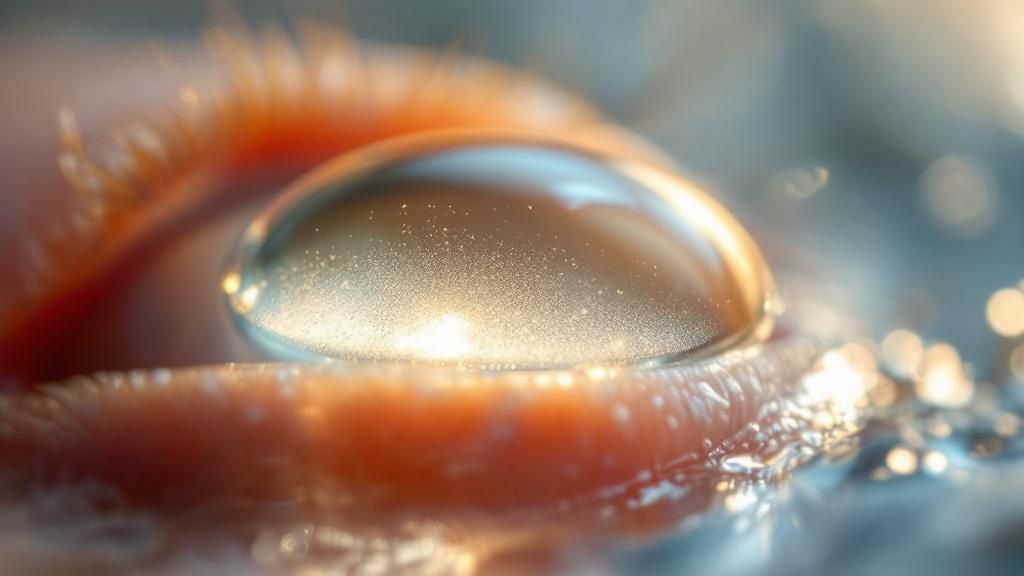
So, what exactly is this film that clouds up your lenses? Your tears aren't just water; they're a complex mixture of proteins, lipids (oils), and other natural substances designed to protect and lubricate your eyes. When you place a contact lens on your eye, these components naturally start to cling to its surface.
Think of it like the ring that forms inside a coffee mug you use every day. It’s a normal process, but without regular, proper cleaning, that film builds up. When it happens on your contact lenses, it can cause a whole host of problems that many of our patients from the Carol Stream area know all too well.
Protein Deposits At a Glance
| Concern | What It Is | Why It Matters | Key Solution |
|---|---|---|---|
| Causes | Natural proteins and lipids from your tear film sticking to the lens surface. | This is a normal biological process for all contact lens wearers. | Consistent and effective daily cleaning. |
| Symptoms | Hazy or foggy vision, gritty or sandy feeling, redness, and general discomfort. | The buildup obstructs clear vision and irritates the eye's surface. | Proper rubbing and rinsing with the right solution. |
| Complications | Can increase the risk of eye infections, allergic reactions (GPC), and corneal issues. | A compromised lens surface can harbor bacteria and reduce oxygen flow. | Following your replacement schedule and using enzymatic cleaners if needed. |
| Prevention | Daily disposables, effective cleaning routines, and choosing the right lens material. | Proactive care is the best way to ensure comfort and eye health. | Regular eye exams and consulting your optometrist about lens options. |
Understanding these points is the first step toward getting control over your lens comfort and clarity.
The Real Impact of Protein Buildup
When this nearly invisible film of protein takes over your lenses, it does more than just annoy you. It directly impacts your vision and the health of your eyes in a few key ways.
- Blurry or Foggy Vision: This is the number one complaint. The buildup scatters light as it enters your eye, creating a persistent haze that blinking won't fix.
- Discomfort and Irritation: A lens coated in deposits is no longer smooth. It can feel scratchy or like you have an eyelash stuck in your eye, leading to redness and making you want to rip your contacts out.
- Reduced Oxygen to Your Eye: A thick layer of gunk can act as a barrier, preventing the healthy flow of oxygen to your cornea. Over time, this can contribute to dryness and other more serious eye health issues.
Finding the right contact lenses and care routine for your specific tear chemistry makes all the difference. To learn more about how we help patients find their perfect match, check out our guide on contact lens fitting and finding the right lenses for your eyes. Our mission is to make sure every patient in Glendale Heights and beyond can enjoy wearing contacts without compromise.
What Are Protein Deposits on Contact Lenses?
Think about what happens to a glass you leave out for a while—it gets a little filmy, right? Something similar happens with your contact lenses, but on a microscopic level. Your tears aren't just saltwater; they're a complex cocktail of proteins, oils (lipids), and other natural substances designed to keep your eyes healthy and lubricated. One of the key players here is a protein called lysozyme, which is crucial for eye health.
The moment you put a contact lens in, it's sitting directly in this tear film. Naturally, some of those proteins and lipids will start to cling to the lens surface. This is a completely normal process. But as you wear your lenses throughout the day, these substances can accumulate layer by layer, eventually forming a hazy, cloudy film.
Why Different Lenses Collect Buildup Differently
Not all contact lenses are created equal when it comes to buildup. The material and type of lens you wear play a big role in how quickly these deposits can form.
-
Soft Contact Lenses: These are often the biggest magnets for protein buildup. Their soft, porous material is designed for comfort and oxygen flow, but that same design can act like a sponge, soaking up proteins directly from your tear film.
-
Silicone Hydrogel Lenses: These newer-generation lenses are fantastic for letting more oxygen reach your eye. However, their material properties can sometimes make them more likely to attract lipid deposits instead of proteins. This is a perfect example of why a professional fitting is so critical—we need to match the lens material to your unique tear chemistry.
-
Hard Lenses (RGPs): Rigid gas permeable lenses have a much smoother, non-porous surface, which means proteins have a harder time sticking to them. Still, they aren't immune and require consistent daily cleaning to stay clear and comfortable.
This gradual accumulation is exactly why a daily cleaning routine is non-negotiable for anyone wearing reusable lenses. Without it, the deposits harden and become much more difficult to remove, impacting both your vision and your comfort. Each type of lens interacts with your tears in its own way, which is why understanding the right lens type for you is the first step toward avoiding these issues.
Finding the right combination of lens and cleaning solution is part science, part art. Some people simply produce more protein in their tears, making them prone to buildup even with perfect cleaning habits. This is a common challenge we help patients from Carol Stream and the surrounding communities solve every day. At iDoctor, our goal is to find a solution that works with your eyes, not against them, so you can enjoy crisp, comfortable vision all day long.
How to Spot the Signs of Protein Buildup in Carol Stream
https://www.youtube.com/embed/JqqtKbMHyr8
So, how can you tell if protein deposits are the culprit behind your contact lens troubles? Your eyes are actually pretty good at sending up a flare when something's not right. Catching these early warnings is the key to keeping your eyes comfortable and healthy.
One of the first things people notice is a distinct change in how their lenses feel. They might suddenly feel gritty, or you might get that annoying sensation that an eyelash is trapped under the lens. This feeling often hangs around even after you've just cleaned your contacts and put them back in. For many of our patients here in Glendale Heights, that persistent gritty feeling is the first sign that buildup is starting to become a problem.
From Hazy Vision to Redness
Beyond just feeling off, protein deposits can really mess with your vision. It's not just about comfort; it's about clarity.
Here’s what to watch out for:
- Hazy or Foggy Vision: This is the classic symptom. It’s like trying to see through a perpetually smudged window, and blinking doesn't do a thing to clear it up.
- Persistent Redness and Irritation: If your eyes are consistently red and feel irritated all day long, the deposits are a likely suspect. That rough, coated lens surface can easily aggravate the delicate tissues of your eye.
These symptoms are your body's way of saying the clean, smooth surface of your contact lens isn't so smooth anymore. The gunk gets in the way of the natural, seamless interaction between the lens, your tear film, and your cornea.
"I thought my vision was just getting worse. Dr. Patel at iDoctor explained it was just protein buildup on my monthly lenses. Switching to a better daily lens made an incredible difference. It's worth the drive from Carol Stream!"
Spotting these signs early makes all the difference. It means you can tackle the protein buildup before it escalates into major discomfort or, worse, potential eye health complications. Many of our patients from Carol Stream and surrounding towns trust iDoctor to pinpoint these exact issues during our 30-minute detailed eye exams.
Your first line of defense is always a rock-solid cleaning routine. If any of this sounds familiar, it might be time to take a closer look at your daily habits. For a complete rundown, check out our guide on the best way to clean contacts for healthier eyes. Don't ignore what your eyes are trying to tell you—it’s always better to be proactive.
Are All Protein Deposits on Lenses Bad News?
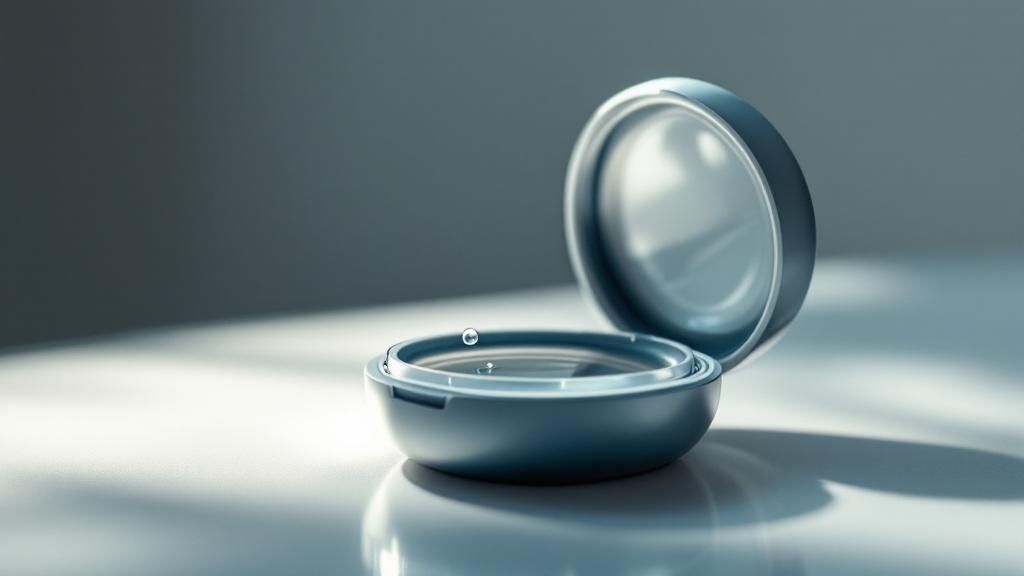
It’s easy to think of any buildup on your contact lenses as the enemy. For years, we’ve been told that contact lens protein deposits are something to be scrubbed away at all costs. While it's true that excessive buildup leads to blurry vision and major discomfort, the real story is far more fascinating.
It turns out, not all deposits are created equal. Some might actually be good for you.
This surprising twist comes down to the specific proteins floating around in your natural tears. Your tear film is much more than just salty water; it's a complex, protective shield packed with substances designed to keep germs out. When some of these proteins bind to your lenses, they don't just become useless gunk.
The Protective Side of Protein Deposits
Believe it or not, certain proteins that stick to your lenses can actually keep doing their job—defending your eye. Think of it as your eye’s personal security team setting up a forward operating base right on your contact lens.
Historically, all protein buildup was seen as a source of irritation and a potential risk for infection. But we're now learning that key tear proteins, like lysozyme and lactoferrin, can continue to act as antibacterial agents even after they've settled on a lens. They essentially make the lens surface a less welcoming place for harmful bacteria to grow.
This is a huge shift in thinking. It means that, under the right circumstances, a certain level of protein on your lenses could be helping to protect your eyes.
A New Approach to Contact Lens Comfort
This new understanding is completely changing how contact lenses are designed. Instead of just making materials that repel all deposits, manufacturers are now engineering lenses that work with your eye's natural chemistry. The goal is to create a surface that encourages beneficial proteins to settle while keeping the problematic ones from sticking around.
For our patients in Carol Stream and Glendale Heights, this lets us be more strategic than ever. At iDoctor, our approach is to understand your unique tear film and lifestyle. This helps us find lenses that strike the perfect balance between clarity, health, and comfort.
We believe that finding truly comfortable contact lenses for your eyes goes beyond just your prescription. It’s about matching the most advanced lens technology to your individual biology.
A Practical Guide to Preventing Protein Deposits
When it comes to keeping your contact lenses clean and comfortable, an ounce of prevention is truly worth a pound of cure. It's far easier to stop protein deposits from forming in the first place than it is to deal with stubborn, vision-blurring buildup later. For contact lens wearers in Carol Stream and the greater Glendale Heights area, creating a simple, consistent care routine is your best defense for healthy eyes and crystal-clear sight.
The most important habit you can build is the "rub and rinse" method. It might sound a bit old-school, but it's hands-down the most effective way to keep your lenses clean. Just place a lens in your palm, add some fresh solution, and gently rub it with your finger for about 20 seconds. This physical friction is what actually dislodges the proteins and lipids clinging to the surface. A simple rinse just can't do the same job.
Choosing Your Cleaning System
Not all contact lens solutions are the same. The right one for you really depends on your type of lenses, your personal tear chemistry, and even your lifestyle.
- Multipurpose Solutions: These are the all-in-one workhorses of lens care, handling everything from rinsing and disinfecting to storing. They're incredibly convenient, but if you're someone who naturally produces a lot of deposits, they might not have enough cleaning power.
- Hydrogen Peroxide Systems: If you have sensitive eyes or struggle with buildup, these systems are fantastic. They provide a much deeper, preservative-free clean. You'll use a special case that contains a neutralizing disc, which converts the potent peroxide into a gentle saline solution, making it perfectly safe to put the lenses in your eyes.
Research has shown that while both types of solutions work, lenses cleaned with a hydrogen peroxide system often end up with slightly less protein deposition. For some people, that small difference can be a game-changer for comfort and clarity.
This visual guide breaks down a simple yet powerful routine for keeping your lenses pristine.
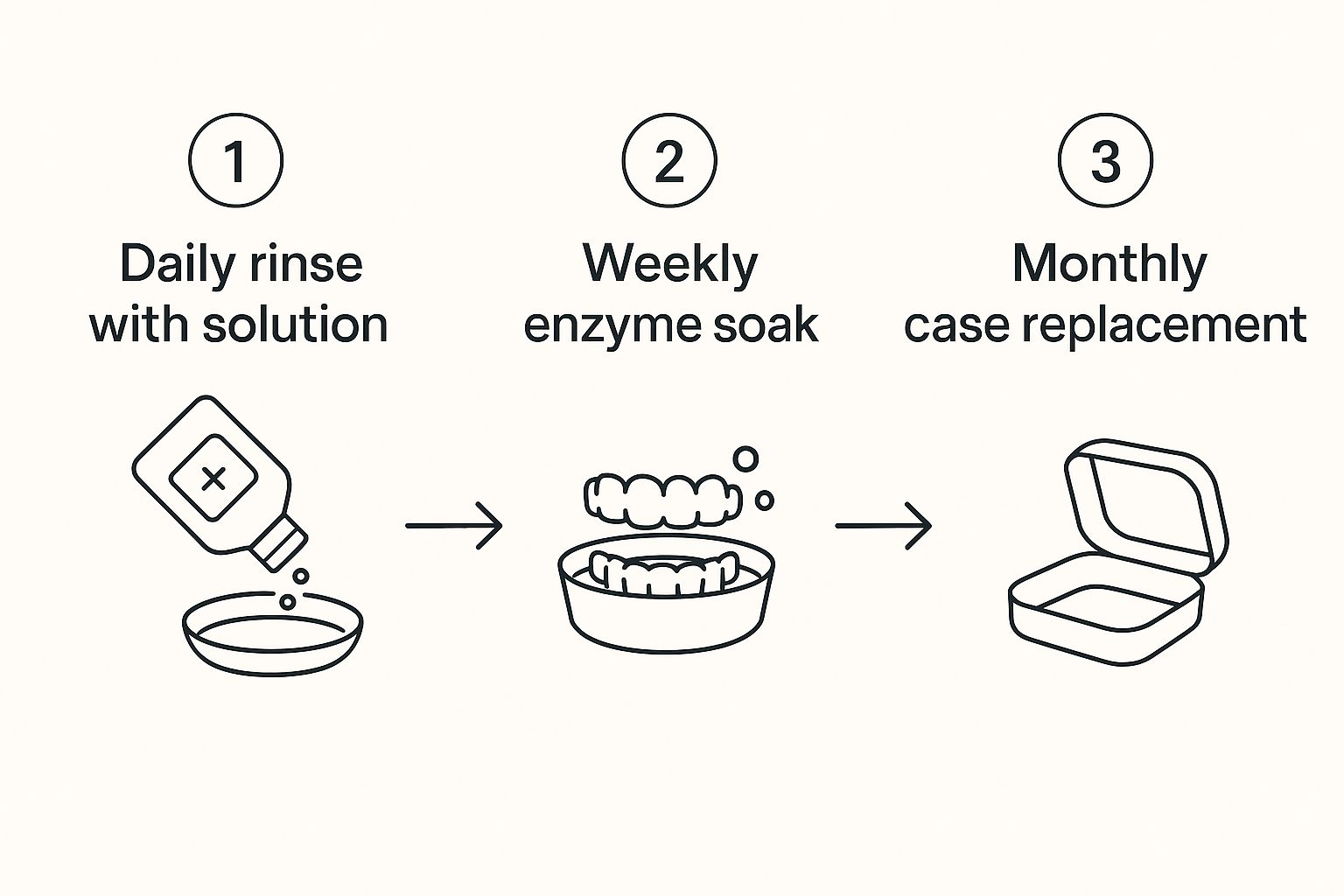
Think of this as your roadmap to daily, weekly, and monthly care. Following these steps helps stop deposits from ever getting a foothold.
The Unbreakable Rules of Lens Care
Beyond the daily rub and rinse, a few ground rules are absolutely essential. Sticking to them will help you avoid not just annoying deposits, but also serious eye infections.
- Always Use Fresh Solution: Never, ever top off the old solution in your lens case. Dump it out completely and refill the case with fresh solution every single time. Used solution loses its disinfecting power and can become a breeding ground for nasty bacteria.
- Clean Your Case Daily: Your lens case needs a daily cleaning, too. After you put your lenses in your eyes, rinse the case with fresh solution—never tap water!—and let it air dry upside down with the caps off. To be safe, toss it and start with a new one at least every three months.
- Stick to Your Replacement Schedule: This one is non-negotiable. Whether you wear dailies, two-week, or monthly lenses, don't try to stretch their lifespan. Old lenses are a magnet for deposits and bacteria. Following the schedule your optometrist gives you is one of the simplest and most effective ways to keep your eyes healthy.
These practices are crucial for every contact lens wearer. For more expert advice, check out our guide on how to prevent common contact lens infections. If you’re a patient from Carol Stream who feels like you’re constantly fighting buildup, a consultation at iDoctor can help us pinpoint a lens and care system that finally brings you lasting relief.
Your Partner for Healthy Eyes in Glendale Heights
Think of clear, comfortable contact lens wear as a partnership—one between you and your eye doctor. Here at iDoctor, we're dedicated to being your guide on that journey. As we've covered, understanding things like contact lens protein deposits, knowing the warning signs, and sticking to a great cleaning routine are the cornerstones of healthy vision for years to come.
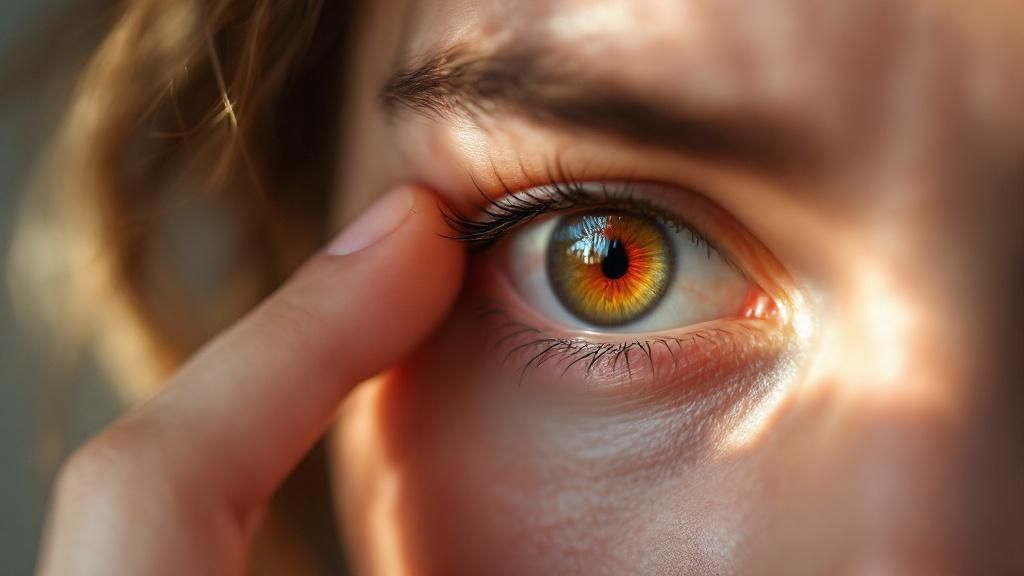
We're big believers in patient education and truly personalized care that goes far beyond a quick, standard check-up. This is why we insist on 30-minute detailed eye exams. That dedicated time allows us to really dig in and find the perfect contact lens and care plan that fits your specific eyes and lifestyle. Our job isn't just to write a prescription; it's to be your long-term partner in maintaining your vision.
For families in Glendale Heights and our neighboring communities like Carol Stream, choosing iDoctor means choosing a local boutique that's genuinely invested in your well-being. From our advanced diagnostic tools to a hand-picked selection of premier eyewear from brands like Cartier, Gucci, and Tom Ford, we provide a complete, high-end eye care experience. We also proudly accept all major vision insurance plans to make exceptional care accessible.
Your Local Contact Lens Questions Answered
H3: Why are my contacts still cloudy even if I live in Carol Stream and clean them daily?
This is one of the most common frustrations we hear from patients. If your lenses are foggy despite a good cleaning routine, the issue is likely a mismatch between your tear chemistry and your lens material. Some people naturally produce more proteins or lipids (oils), and conditions like dry eye can make it worse. Switching to a different lens material or a more powerful hydrogen peroxide cleaning system often solves the problem. During one of our detailed eye exams in Glendale Heights, we can diagnose the cause and find a better solution for you.
H3: Are daily contact lenses a good option to avoid protein buildup?
Absolutely. For many of our patients from Carol Stream and the surrounding towns, switching to daily disposables is a game-changer. Since you start with a fresh, sterile pair every morning, deposits don't have time to build up and cause fogginess or irritation. It's the simplest and most effective way to guarantee clear, comfortable vision all day, every day.
H3: I need a contact lens exam near Carol Stream, how often should I get one?
We recommend a comprehensive contact lens exam every year, even if your vision seems stable. An annual exam at our Glendale Heights boutique allows us to check for subtle issues caused by lens wear, ensure your contacts still fit perfectly, and catch potential health problems early. It's essential preventative care for maintaining the health of your eyes long-term.



